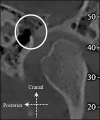An Investigation of the Morphology of the Petrotympanic Fissure Using Cone-Beam Computed Tomography
- PMID: 29707183
- PMCID: PMC5913417
- DOI: 10.5037/jomr.2018.9104
An Investigation of the Morphology of the Petrotympanic Fissure Using Cone-Beam Computed Tomography
Abstract
Objectives: The purpose of the present study was: a) to examine the visibility and morphology of the petrotympanic fissure on cone-beam computed tomography images, and b) to investigate whether the petrotympanic fissure morphology is significantly affected by gender and age, or not.
Material and methods: Using Newtom VGi (QR Verona, Italy), 106 cone-beam computed tomography examinations (212 temporomandibular joint areas) of both genders were retrospectively and randomly selected. Two observers examined the images and subsequently classified by consensus the petrotympanic fissure morphology into the following three types: type 1 - widely open; type 2 - narrow middle; type 3 - very narrow/closed.
Results: The petrotympanic fissure morphology was assessed as type 1, type 2, and type 3 in 85 (40.1%), 72 (34.0%), and 55 (25.9%) cases, respectively. No significant difference was found between left and right petrotympanic fissure morphology (Kappa = 0.37; P < 0.001). Furthermore, no significant difference was found between genders, specifically P = 0.264 and P = 0.211 for the right and left petrotympanic fissure morphology, respectively. However, the ordinal logistic regression analysis showed that males tend to have narrower petrotympanic fissures, in particular OR = 1.58 for right and OR = 1.5 for left petrotympanic fissure.
Conclusions: The current study lends support to the conclusion that an enhanced multi-planar cone-beam computed tomography yields a clear depiction of the petrotympanic fissure's morphological characteristics. We have found that the morphology is neither gender nor age-related.
Keywords: arthroscopy; cone-beam computed tomography; temporal bone; temporomandibular joint.
Figures





References
LinkOut - more resources
Full Text Sources
Other Literature Sources
